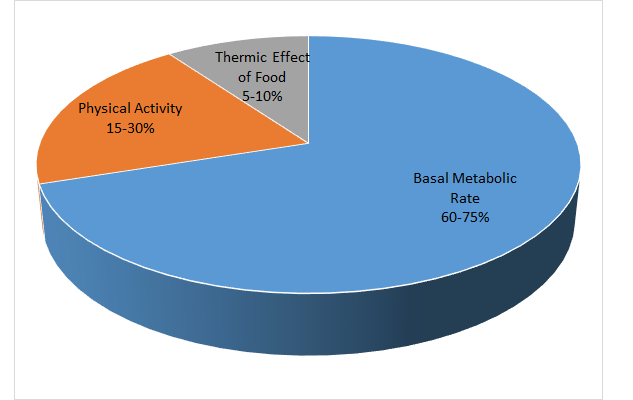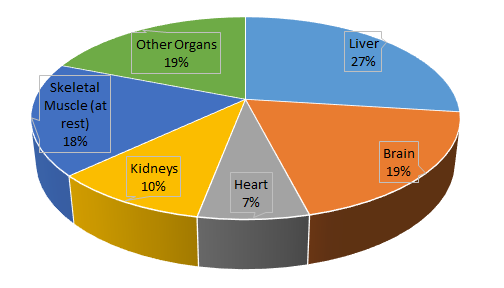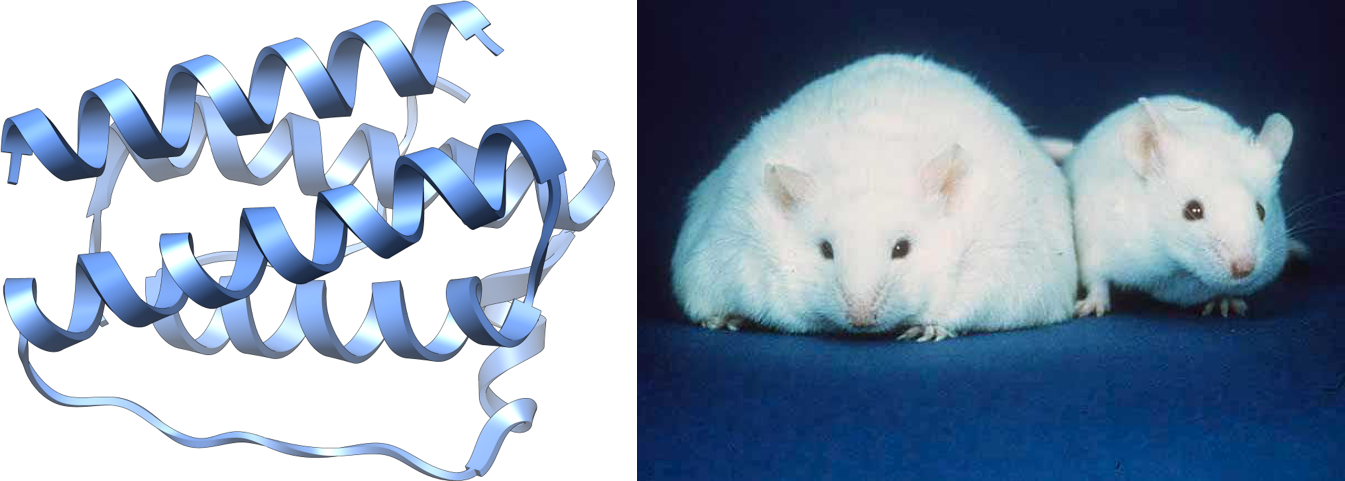Unit 7- Energy Balance and Obesity
7.2 Energy Balance
The concept of energy balance seems simple on paper. Balance the calories that you eat with the calories you burn. But many factors play a role in this concept. Some factors are under our control and others are not. In this section, we will define energy balance then look at the different components of expenditure and the factors that influence it. We’ll also consider why energy balance is more complex than it seems.
Energy Balance
Your body weight is influenced by the energy (calories) you consume and energy that you expend. This relationship is defined by the energy balance equation:
Energy Balance = energy intake minus energy expenditure
When you’re in energy balance, energy intake equals energy expenditure, and body weight should remain stable.[1]

Positive energy balance occurs when energy intake is greater than expenditure, usually resulting in weight gain.

Negative energy balance is when energy intake is less than expenditure, usually resulting in weight loss. (This is desirable for those on weight loss diets.)

Energy intake consists of the calories we consume from food and beverages. These calories come from the macronutrients (carbohydrates, proteins, and fats) and alcohol.
In theory, if you consume 3,500 more calories than your body needs, you will gain about one pound, because a pound of fat provides about 3,500 calories. (Remember that when you eat too many calories, the excess is stored as fat.) If you burn 3,500 more calories than you consume, you will lose about a pound, as your body starts using these stored calories for energy. However, in practice, the way we respond to an excess or deficit of 3500 calories can be quite variable, and over time, the body adapts to these conditions and resists changes in body weight. (This makes cutting calories to lose weight difficult.)
Energy balance is complex and varies between individuals—something we’ll explore a bit more later in this section—but it is still a vital concept in understanding body weight.
Components of Energy Expenditure
The sum of caloric expenditure is referred to as total energy expenditure (TEE). The three main components of TEE are:
- Basal metabolic rate (BMR)
- Thermic effect of food (TEF)
- Physical activity

Figure 7.3. Components of total energy expenditure include basal metabolism, the thermic effect of food, and physical activity.
1. Basal Metabolic Rate (BMR)
BMR is the energy used by your body at rest. These are the “behind-the-scenes” activities that are required to sustain life. Examples include:
- Breathing
- Blood circulation
- Protein synthesis
- Nervous system activity
- Body temperature regulation
If a person is sedentary or moderately active, BMR is the largest component of energy expenditure, making up about 60 to 75 percent of total energy used. For example, a sedentary person might need about 1800 calories in a day, with about 1200 of them used for basal metabolism.

Figure 7.4. Components of energy expenditure and their percent contribution to the total in sedentary to moderately active people.
BMR can vary widely amongst individuals. An individual’s lean body mass—made up of organs, bones, and muscles—is the biggest determinant of BMR, because lean body tissue uses more calories than body fat. This means that a muscular person burns more calories than a person of similar weight with more body fat. Likewise, increasing your muscle mass can cause an increase in your BMR. However, our skeletal muscles at rest only account for about 18 percent of the total energy expended by lean body mass. Most energy is used to meet the calorie needs of vital organs. The liver and brain, for example, together account for nearly half of the energy expenditure by lean mass as noted in the figure below.

Figure 7.5. Energy expenditure of organs.
BMR depends not only on body composition but also on body size, sex, age, nutritional status, genetics, body temperature, and hormones (Table 7.1). People with a larger frame size have a higher BMR simply because they have more mass. On average, women have a lower BMR than men, because they typically have a smaller frame size and less muscle mass. As we get older, muscle mass declines, and therefore BMR declines as well.
If someone is fasting or starving, or even just cutting calories in an attempt to lose weight, his or her BMR will decrease. This is because our bodies attempt to maintain homeostasis and adapt by slowing down our basic body functions to help preserve energy. This is a protective mechanism during times of food shortages, but it also makes intentional weight loss more difficult.
|
Factors That Increase BMR |
Factors That Decrease BMR |
|
Higher lean body mass |
Lower lean body mass |
|
Larger frame size |
Smaller frame size |
|
Younger age |
Older age |
|
Male sex |
Female sex |
|
Stress, fever, illness |
Starvation or fasting |
|
Elevated levels of thyroid hormone |
Lower levels of thyroid hormone |
|
Pregnancy or lactation |
|
|
Stimulants such as caffeine and tobacco |
|
Table 7.1. Factors that Impact BMR
2. Thermic Effect of Food (TEF)
The energy used to digest, absorb, and store the nutrients in foods is the thermic effect of food. TEF accounts for 5 to 10 percent of total energy expenditure and does not vary greatly amongst individuals. High protein foods have a higher thermic effect than high fat ones making protein diet popular for weight loss.
3. Physical activity
Physical activity is another important way our bodies use energy. Physical activity usually contributes anywhere from 15 to 30 percent of energy expenditure and can be further divided into two parts: EAT and NEAT.
EAT (exercise-related activity thermogenesis) is planned, structured, and repetitive physical activity designed to improve health (participating in a sport like or strength training at the gym, for example).
NEAT (non-exercise activity thermogenesis) is the energy expenditure for unstructured and unplanned activities. This includes daily-living activities like cleaning the house, yard work, walking to class, shopping, and the energy required to maintain posture and spontaneous movements such as fidgeting and pacing. NEAT can vary by up to 2,000 calories a day for two people of similar size.[2]
DID YOU KNOW?
Are you a fidgeter? Do you constantly tap your toes, swing your legs, or move from side to side while sitting at your desk? Researchers have found that fidgeters burn more energy than people who sit motionlessly. The energy burned is above that used for NEAT energy expenditure. So, although it might be annoying to your friends, family, and teachers, it could help you maintain a healthy weight.[3]
Hunger versus Appetite
Hunger is the physiological need to eat. When your stomach is empty, it contracts and starts to grumble and growl. The stomach’s mechanical movements signal the hypothalamus in your brain. (Of course, your stomach also contract when it’s full and hard at work digesting food, but we can’t hear these movements as well because the stomach’s contents muffle the noise.) Your stomach also produces and secretes the “hunger hormone,” ghrelin. Levels of ghrelin are high before a meal and fall quickly after eating.2
Appetite is the psychological desire to eat. Satiety is the sensation of feeling full. After you eat a meal, your stomach stretches and sends a signal to the brain stimulating the sensation of satiety and relaying the message to stop eating. Leptin, known as the “satiety hormone,” is produced by adipose cells as body fat increases. Leptin signals the brain that you are full and to stop eating. [4]
The discovery of leptin’s functions sparked a craze in the research world and the diet pill industry, as it was hypothesized that if you give leptin to individuals trying to lose weight, they will eat less. In several clinical trials, it was found that people who are overweight or obese are actually resistant to the hormone, meaning their brain does not respond as well to it. Therefore, when you administer leptin for weight loss, there is generally no sustained effect on food intake. [5]

Figure 7.6. The structure of the hormone leptin (left), which is primarily produced by adipose tissue. The obese mouse in the photo has a gene mutation that makes it unable to produce leptin, resulting in constant hunger, and severe obesity. For comparison, a mouse with normal leptin production is also shown. Such gene mutations are rare, but they serve as a dramatic illustration of the importance of the hormone in signaling energy balance.
The Complexity of Energy Balance
As we’ve already discussed, how much food we eat each day is not just a matter of willpower or self-control. It’s the result of powerful physiological and psychological forces that tell us if we need to eat, or if we’ve had enough. Our brains are hard-wired to seek food if we’re in negative energy balance, an instinct required for survival. This means that if you start to exercise more—increasing your energy expenditure—you will also feel hungrier, because your body needs more fuel to support the increase in physical activity.
Even measuring how much energy is consumed is not as simple as you might think. We can measure the caloric content of food from a chemical standpoint, but we can only estimate how much energy a person will absorb from that food. This will depend on how well the food is digested and how well the nutrients are absorbed—factors which vary depending on the food itself, the digestion efficiency of the person eating it, and even the microbes living in their gut. Two people may eat the exact same meal, yet not absorb the same number of calories.
Energy expenditure is also dynamic and changes under different conditions, including increased or decreased caloric intake. Decreased caloric intake and going into negative energy balance cause a drop in BMR to conserve energy. Muscles also become more efficient, requiring less energy to work, and without realizing it, people in negative energy balance often decrease their NEAT activity level. These adaptations help to conserve energy and make it more difficult to shed pounds. People may still be able to lose weight despite their bodies working to prevent it, but maintaining a new, lower weight requires constant vigilance, and weight regain is common.
Research has also shown that people respond differently to changes in caloric intake. When a group of people are overfed, the amount of weight gained among study participants varies widely. In a study of identical twins who were given an extra 1,000 calories per day for 100 days, weight gain varied between 10 and 30 pounds among participants. Weight gain between twins was more similar (though not exactly the same), which may be attributed to genetic factors.[6] People gain and lose weight differently; we don’t necessarily follow formulas.
When people say that the answer to the obesity epidemic is to eat less and move more, they’re not wrong. But this is also an oversimplified answer, because of all the complexities underlying energy intake and energy expenditure.
Review Questions
- “Balancing Energy Input with Energy Output”, section 11.2 from the book An Introduction to Nutrition (v. 1.0), CC BY-NC-SA 3.0 ↵
- Chun N et al. (2018). Non-exercise activity thermogenesis (NEAT): a component of total daily expenditure. J Exerc Nutrition Biochem, 22(2), 23–30. ↵
- Levine, J. A., Schleusner, S. J., & Jensen, M. D. (2000). Energy expenditure of nonexercise activity. The American journal of clinical nutrition, 72(6), 1451–1454. https://doi.org/10.1093/ajcn/72.6.1451 ↵
- Austin J. Marks D. (2008). Hormonal Regulators of Appetite. Int J Pediatr Endocrinol. 2009 ↵
- Dardeno T.A. et al. (2010). Leptin in Human Physiology and Therapeutics. Front Neuroendocrinol, 31 (3), 377–93. ↵
- Bouchard C. et al. (1990). The response to long-term overfeeding in identical twins. N. Engl. J. Med. 322, 1477-1482. ↵
The state in which the total energy intake equals total energy needs.
An increase in temperature.
When our bodies produce energy as ATP, a small amount of heat is released.
The production of heat.
A hormone produced in gastrointestinal tract, especially the stomach, and is often called a "hunger hormone" because it increases the desire to eat. Blood levels of ghrelin are highest before meals when hungry, returning to lower levels after mealtimes.
A hormone secreted from fat cells and signals satiety or the feeling of fullness. Therefore, it's known as the "satiety hormone" and makes us stop eating. The term is derived from the Greek word leptos, meaning thin.
Non-exercise activity thermogenesis, are the calories burned by the movements we make during normal living. NEAT includes the physical movement in our lives that isn't planned exercise or sports such walking to class, cleaning house, or shopping.

